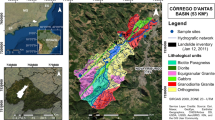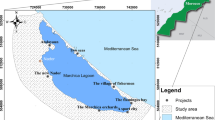Abstract
In a typical unit of structurally complex, mainly shaley and highly tectonized terrain, two different levels of shaley clayey materials in the same site were identified and analyzed. These lithotypes were characterized in terms of their behaviour as a result of swelling phenomena connected with the mineralogy, stress history and variation in water content. The aim of the study was to assess, in particular, the problems caused by cutting and altering the slope composed of these heterogeneous terrains.
Résumé
Dans une formation d’argilites de structure complexe et fortement tectonisée, deux niveaux différents de ces matériaux argileux ont été identifiés et analysés sur un site particulier. L’aptitude au gonflement de ces lithotypes a été caractérisée et mise en relation avec leur composition minéralogique, leur histoire tectonique et les variations de teneurs en eau subies. L’un des buts de l’étude a été d’évaluer les problèmes géotechniques qui peuvent résulter de la réalisation d’excavations et des processus d’altération se développant sur des pentes réalisées dans ces matériaux hétérogènes.













Similar content being viewed by others
References
Associazione Geotecnica Italiana (1985) Geotechnical properties and slope stability in structurally complex clay soils. Geotechnical Engineering in Italy, ISSMFE, Golden Jubilee, pp 189–225
American Society for Testing and Materials (1996) Annual book of ASTM standards. Section 4—construction. ASTM, Philadelphia
Bortolotti V (1992) Dominio ligure esterno—guide geologiche regionali, Appennino Tosco-Emiliano. Società Geologica Italiana, BE-MA editrice, Rome, pp 1–331
BS (1990) British Standard methods of test for soils for civil engineering purposes. 1377: Part 8. Shear strength tests (effective stress). British Standards Institution, London
Calabresi G, Scarpelli G (1985) Effects of swelling caused by unloading in overconsolidated clays. In: Proc 11th Int Conf ISSMFE, San Francisco, Publ 2, pp 411–414
D'Elia B (1980) Processi di ammorbidimento di un'argilla marnosa con strutture a scaglie. In: Proc 14th Convegno Italiano di Geotecnica, Firenze, Publ 2, pp 409–417
Esu F (1977) Behaviour of slopes in structurally complex formations. In: Proc Int Symp The Geotechnics of Structurally Complex Formations, Capri, Publ 2, pp 292–304
Haefeli R, Ambery G (1948) Contribution to the theory of shrinking. In: Proc 2nd Congr ISSMFE, Publ 1
International Society for Rock Mechanics (1989) Suggested methods for laboratory testing of argillaceous swelling rocks. Commission on Swelling Rock and Working Group on Swelling Rock of the Commission on Testing Methods. Int J Rock Mech Min Sci Geomech Abstr 26:415–426
Ravaglioli U (1962) Il fenomeno di rigonfiamento nei materiali argillosi. L'Acqua 6:149–159
Smith RE, Wahls HE (1969) Consolidation under constant rates of strain. ASCE J Soil Mech Found Div 95(42):519–539
Wissa A, Christian J, Davis E, Hiberg S (1971) Consolidation at constant rate of strain. ASCE Soil Mech Found Div 97(10):1393
Author information
Authors and Affiliations
Corresponding author
Rights and permissions
About this article
Cite this article
Garzonio, C.A., Sfalanga, A. Geomechanical characterization of a tectonized shaley complex in the hilly area around Florence. Bull Eng Geol Environ 62, 289–297 (2003). https://doi.org/10.1007/s10064-003-0194-5
Received:
Accepted:
Published:
Issue Date:
DOI: https://doi.org/10.1007/s10064-003-0194-5




